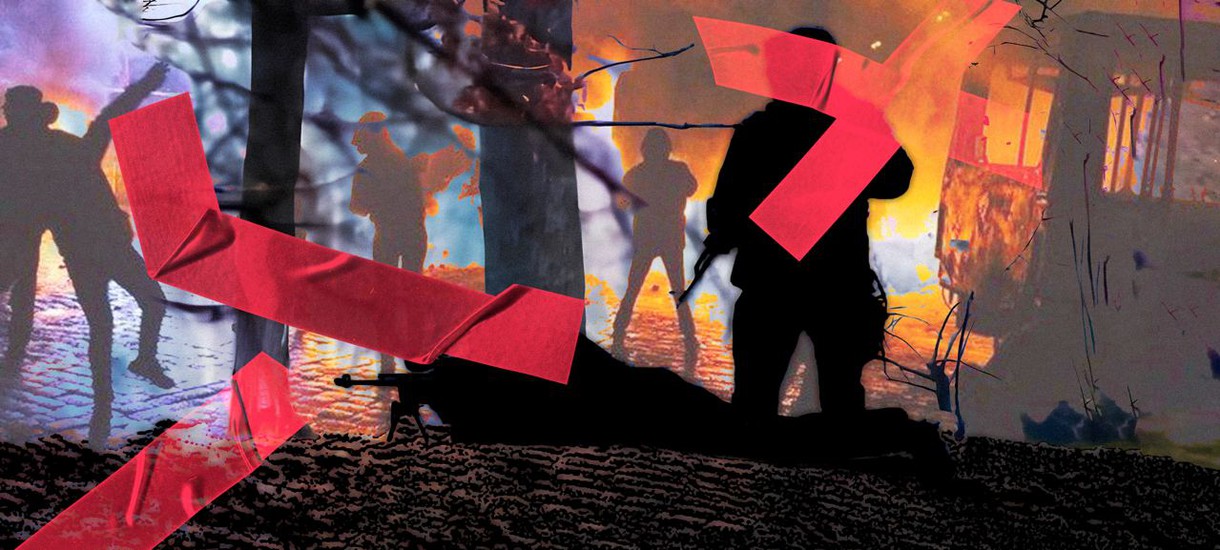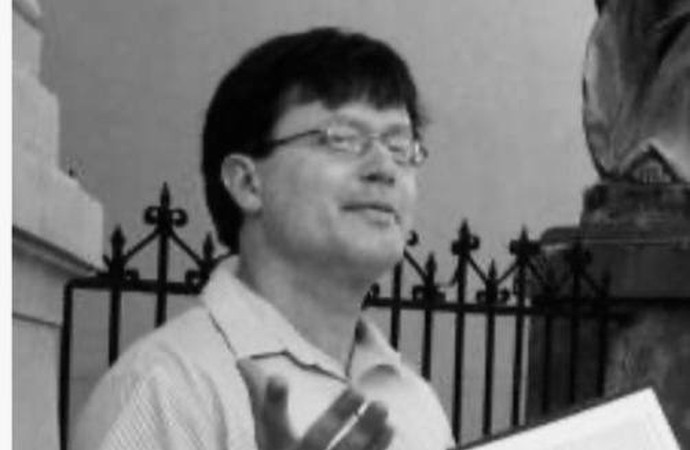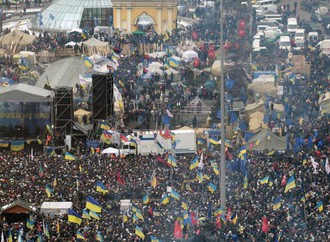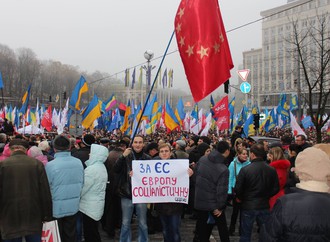A decade ago, the Euromaidan protests successfully toppled the Yanukovych government. Paradoxically, nobody faced justice for the bloodiest attack against the protesters, the mass shootings of people who went up Instytutska Street on 20 February. All the killed supporters of Euromaidan became immortalized as the Heavenly Hundred, with their names and photos being publicly displayed on the Maidan and in some Ukrainian cities. In contrast, the names of the perpetrators remain murky despite several investigations and trials. Such a situation led to various speculations, which even blamed the Euromaidan leadership for a false flag operation to discredit Yanukovych, his government and the riot police.
The following text by historian William Risch discusses investigations of the 20 February shootings. It is part of a chapter of his upcoming book, which he kindly shared with us before publication. The book covers Euromaidan, the anti-Maidan protests, and the Russian intervention (before February 2022) that followed them. This section criticizes Ivan Katchanowski's version of the 20 February shootings, providing publicly available evidence about those events.
William Risch is a professor of history at Georgia College in the United States. His area of expertise is Modern European, Soviet and Ukrainian history. He is the author of The Ukrainian West: Culture and the Fate of Empire in Soviet Lviv.
The ‘Maidan Massacre’ Theory
The collapse of the Yanukovych regime following the Maidan shootings has prompted much speculation over who really was behind them. Ivan Katchanovski has been the most outspoken in this regard. He has asserted in articles that opposition politicians and far-right nationalists organized and carried out what he refers to as the ‘Maidan massacre’. He states that they staged a false-flag operation to place the blame for the bloodshed on Ukrainian security forces, which caused the West to put greater pressure on Yanukovych to make considerable concessions to the Maidan, concessions Yanukovych could not afford to make[1].
Katchanovski studied extensively the shootings themselves, as well as investigations into the February 20 Maidan shootings, and trials of five Berkut men (two commanders and three soldiers) under arrest. These trials were disrupted after the five suspects were released as part of a 2019 prisoner exchange with Russia. They were renewed after two of them returned from the self-proclaimed Donetsk People’s Republic to prove their innocence.
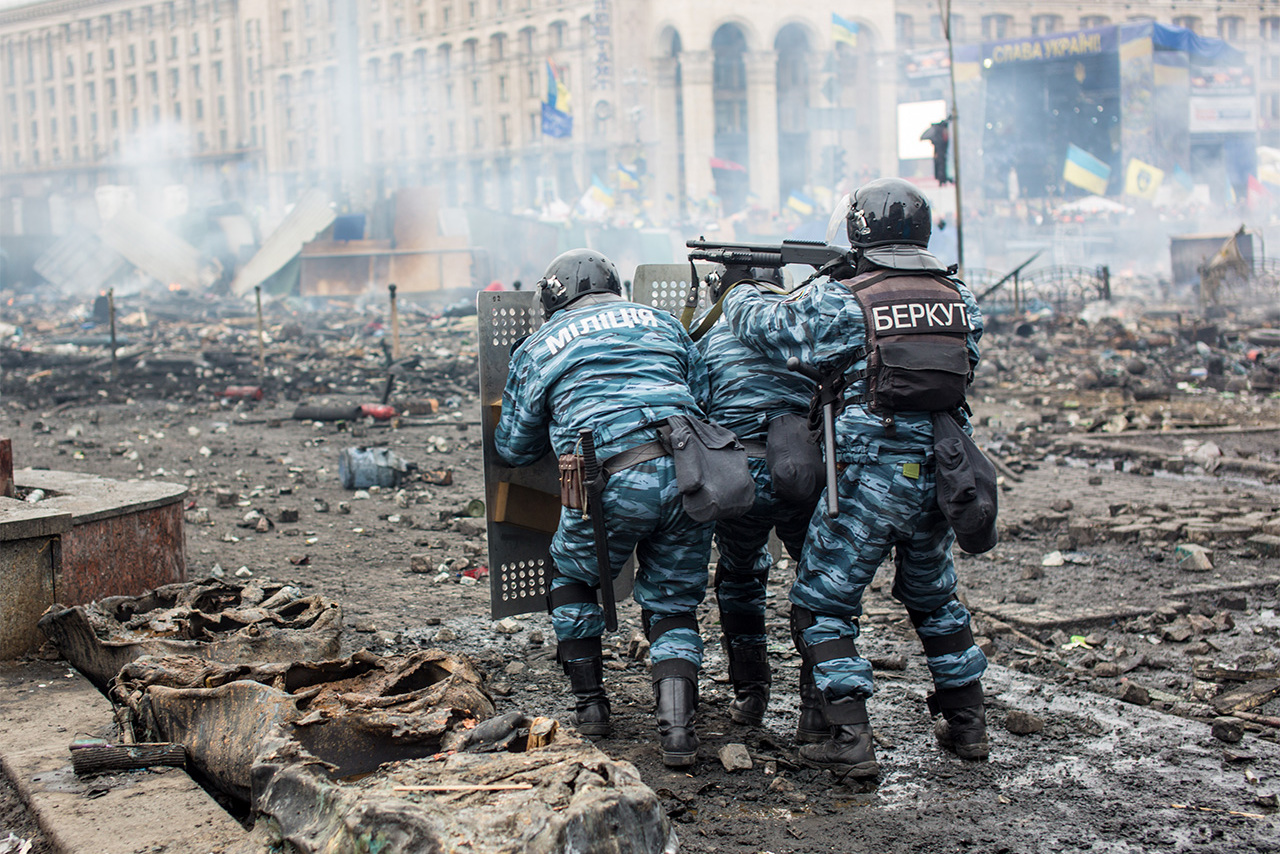
Berkut troops at Independence Square
Katchanovski’s arguments go as follows. He argues that Ukraine’s post-Maidan government sabotaged and covered up what had happened that day. Victims’ medical autopsy reports and initial ballistic investigations by prosecutors indicated that the first protesters killed had been shot from the Hotel Ukraine and the Conservatory which bordered the Maidan. Prosecutors then stopped further ballistic analysis and relied almost entirely on medical forensic experts to determine who had shot the victims and from where. The medical experts themselves admitted this was not standard practice, and even a judge chided investigators for relying on medical forensic analysis alone and for throwing out eyewitness testimony that shots had come from Maidan-held buildings.
Numerous eyewitnesses claimed snipers were firing from the Hotel Ukraine, which was under protesters’ control then, and from the roofs of other buildings not under government forces’ control. Contrary to the statements by Ukrainian media and Ukrainian prosecutors, most were not killed by the Berkut troops and other government forces standing behind their Instytutska Street barricade made of concrete blocks and trucks. Government forces stationed on roofs of nearby buildings or behind the Instytutska Street barricade – Alfa troops, Omega forces, and UDO [Ukrainian State Guards] forces – testified that they had been deployed only after the massacre had started, and their job was to take out the snipers allegedly firing on both police and protesters. Some protesters (such as the Right Sector activist Kii) even claimed publicly that Petro Poroshenko, then an opposition politician, and Dmytro Iarosh, leader of Right Sector, had provided cover for these snipers from the Maidan side, letting them escape from Kyiv with other riot policemen captured on February 20[2].
Katchanovski is critical of a 3-D computerized study of three protesters’ deaths used as evidence in the Maidan shootings trial. The study, conducted by SITU Research, an architectural firm in Brooklyn that dealt with video forensics, used extensive video, photo, and cell phone data collected by Lviv activist Evelyn Nefertari. Katchanovski argues that the demonstration made by SITU Research ignores medical autopsies of the victims. Substituting artificial intelligence (AI) for real ballistic analysis, it moved the wounds to fit the direction from which Berkut forces fired their bullets[3].
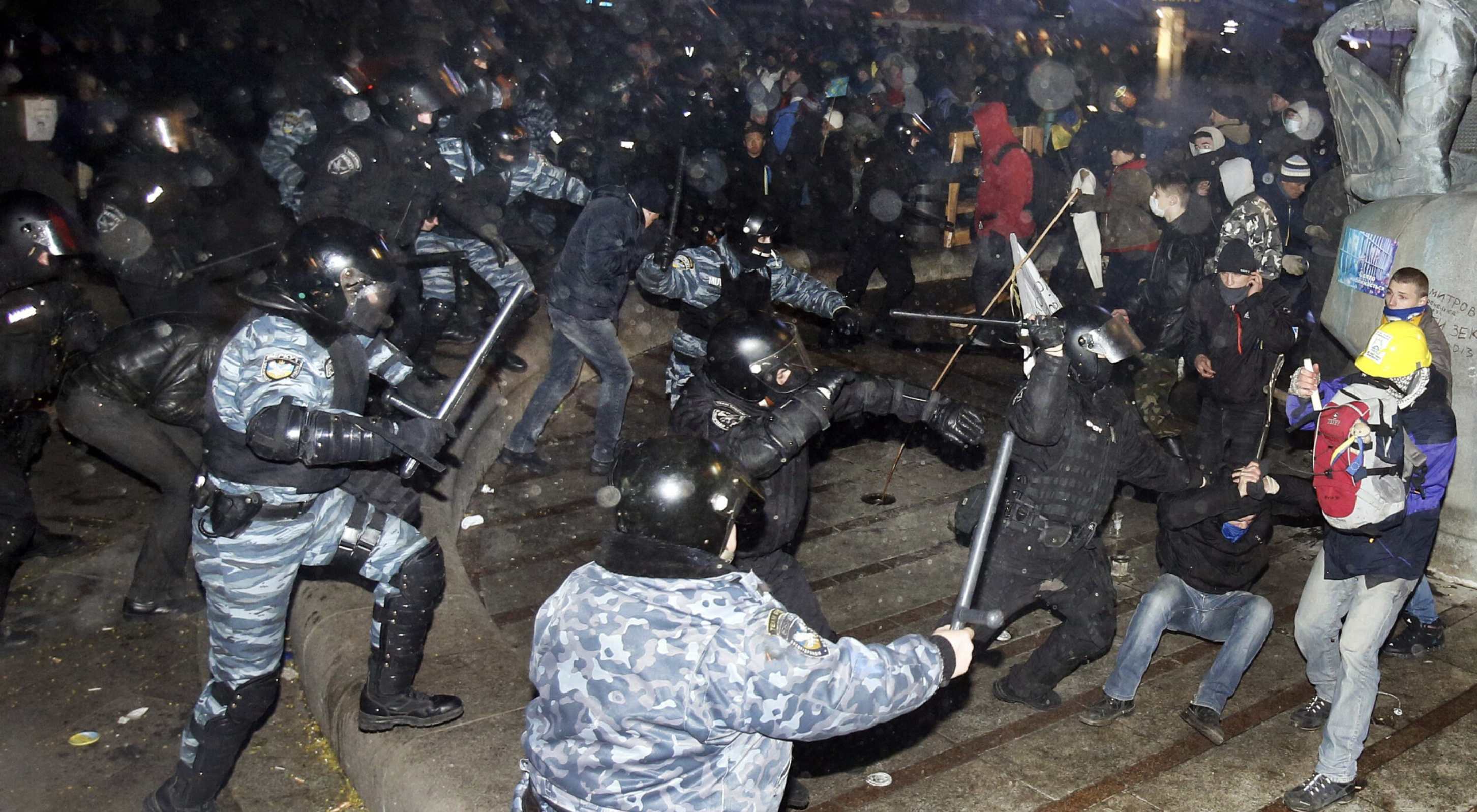
Dispersal of a peaceful rally in support of Ukraine's European integration at Independence Square, November 30, 2013, Kyiv, Ukraine. Photo: STR / AFP via Getty Images
Botched investigations
Katchanovski leaves out important nuances in these investigations. A report by an International Advisory Panel dealing with the Maidan investigations, sponsored by the Council of Europe, and issued on March 31, 2015, noted several problems with them that did not involve intentional tampering by political leaders. These were problems that made any probe into the shootings problematic for any government official. Most of the crimes committed against protesters had taken place on Maidan-held territory. This kept law enforcement from searching any scenes where there were victims, or where protesters had been suspected of shooting others.
The bodies of the dead and injured had often been moved. These factors undermined the investigation of bullet trajectories. Medical records of Maidan victims had been made in different places and were often incomplete. Injured protesters were treated at on-site medical centers out of necessity or out of fear of retaliation by government forces. Hospitals failed to preserve evidence like bullets extracted. Government documents disappeared, either stolen or destroyed. For instance, the Ukraine’s Prosecutor General and his deputy reported that the Ministry of the Interior’s files on those Maidan protesters shot and killed on January 22, 2014, on Hrushevsky Street were essentially empty.
Because Yanukovych-era officials focused on investigating victims – that is, protesters – and not the perpetrators of murders, no real government investigation into the shootings happened until the last week of February 2014. The protests, the violence committed against protesters, and the crime scene were extensive. Because law enforcement lacked identification badges and often wore face masks or carried shields, it became difficult identifying any potential perpetrators from their side. The report did not mention problems facing the investigation of security forces’ murders. Yet they were most likely analogous to these other cases[4].

Berkut attacks demonstrators during a protest on January 22, 2014. Photo: epa
The International Advisory Panel emphasized that considerable numbers of high-ranking officials had fled Ukraine and could not be investigated for their role in incidents like the February 20 shootings. Senior members of the government, such as the heads of the Ministry of the Interior, the SBU, and the Prosecutor General of Ukraine had fled, as had large numbers of officials under them. Ukraine was unable to extradite them. The Russian Federation ignored all of the over 400 extradition requests made by the post-Maidan government’s Ministry of the Interior since late February 2014. Law enforcement and security organs had to deal with subordinates possibly implicated in Maidan crimes.
Thus, the Main Investigation Department of the General Prosecutor of Ukraine had to investigate white-collar crimes and abuse of power crimes as well as Maidan-related crimes of high-ranking officials. The General Prosecutor of Ukraine’s staff had been reduced before the Maidan protests to make way for the formation of a State Bureau of Investigations, which had not yet been set up at the time of the Maidan. Thus, the Prosecutor General of Ukraine’s office faced considerable staffing problems as well as an avalanche of criminal cases. Later events in 2014, involving Crimea’s annexation by Russia, pro-Russian uprisings in Ukraine’s south and east, and the war in the Donbas distracted investigators further from their work on Maidan-related crimes[5]. Three months of no investigations into Maidan crimes at all, before February 22, 2014, had led to serious delays with investigations into such crimes, especially violent crimes. By November 2014, for instance, the General Prosecutor of Ukraine’s office said that it still did not have the results of ballistic tests on weapons that the Ministry of the Interior’s Omega unit had been armed with in February 2014. There had been delays with forensic examinations as well[6].
While Katchanovski emphasizes that there was no documented evidence of Yanukovych or his officials issuing orders to shoot protesters on February 20, the International Advisory Panel stressed that Yanukovych’s regime carried out operations against protesters without leaving a written record behind. Records were either not made at all, and orders were given by word of mouth, or they were stolen or destroyed[7].
One instance cited in the report by the International Advisory Panel reveals just how far Yanukovych-era officials went in obfuscating the Maidan shootings after their leaders had fled the country. On the night of April 2-3, 2014, General Prosecutor of Ukraine investigators managed to detain and question a Berkut commander and two Berkut officers. Right then, armed men from Berkut surrounded the building and threatened to storm it if the investigators did not release the detainees. Following negotiations, the investigators released the three Berkut officers. A fourth Berkut officer asked to stay and answer questions so he could avoid pretrial detention.

Berkut special forces officer on Hrushevskyi Street in Kyiv, January 19, 2014. Photo: Mstislav Chernov
At one point that night, this Berkut officer received a call on his cell phone from the Kyiv Berkut’s office saying that he should not give any testimony and instead wait for them to provide him with a lawyer. The Berkut officer refused and said he was ready to tell the truth. Prosecutor General of Ukraine investigators recorded this call. When they sought a record of the call’s log from the cell phone provider, though, the log entry had disappeared, suggesting that someone from the Ministry of the Interior might have removed it illegally. Prosecutor General of Ukraine investigators provided other evidence suggesting that superiors in the Ministry of the Interior, as well as court judges, had colluded in shielding Berkut officers from prosecution and enabling nearly all of them, as well as their commander, to flee the country. The International Advisory Council voiced particular concern about Ministry of Interior officials obstructing prosecutors in their investigation of Berkut’s role in the February 20 shootings. It accused Berkut officers of acting with impunity in April 2014 and their superiors in the Ministry of Internal Affairs of allowing them to get away with it[8].
Despite all these problems faced by government investigators, the International Advisory Panel emphasized that this was not an excuse for shortcomings in the investigation. The post-Maidan government’s failures to investigate Maidan-related crimes were not an inevitable outcome of these circumstances. Thus, a critique of these government investigations, and the media’s treatment of them, is warranted[9].
The failure of Katchanovski’s theory
The problem is that Katchanovski’s own attempt at reconstructing and explaining the Maidan shootings is not of high quality either. When far-right activists complain that Iarosh and Poroshenko had them escort snipers to safety, they do not indicate whether these snipers were from the government side or the Maidan side. Katchanovski automatically concludes that they had to have come from the Maidan side. Failing to provide evidence beyond a reasonable doubt in court that Berkut forces committed crimes does not mean that the Maidan side did them. The unknown shooters firing from different directions, including the roofs of area buildings, remain unknown.
Katchanovski insinuates that the Svoboda (Freedom) Party’s politicians were behind the Maidan shootings because they controlled the Hotel Ukraine. He cites remarks two of their politicians gave to the Kapranov brothers, Vitaliy and Dmytro, complaining that Western partners had no plans to intervene in the Maidan events until over 100 people had been killed. Their point had been that the West was indifferent to the Maidan protesters, a theme repeated throughout the Kapranov brothers’ book and the activists and leaders of the Svoboda Party that the Kapranov brothers so generously quote[10]. Katchanovski infers some kind of master plan to kill Yanukovych that day, based on what Ivan Bubenchyk had told a Babylon ’13 documentary: “He [Bubenchyk] also said that Yanukovych was supposed to be killed on February 20.” In fact, in that segment of the documentary, Bubenchyk laments that they should have shot and killed Yanukovych like a dog that day, because, two years on, so much remained unfinished when it came to the Maidan’s revolution[11].
Katchanovski dismisses a lengthy video made by a former press secretary for the Lviv Regional Council, led then by a member of the Svoboda Party, which had filmed the events on Instytutska Street for nearly an hour. Because the video was filmed from a Hotel Ukraine window on the building’s corner, where snipers allegedly had been seen, and because there were cuts in the video, Katchanovski insinuates that Svoboda Party supporters were using that window both to film the carnage and contribute to the carnage. In fact, the video, despite its cuts, records a man who repeatedly curses and swears, and cries, as Berkut forces from behind the Instytutska Street barricade made of concrete blocks and trucks fire on protesters, killing and injuring them[12].
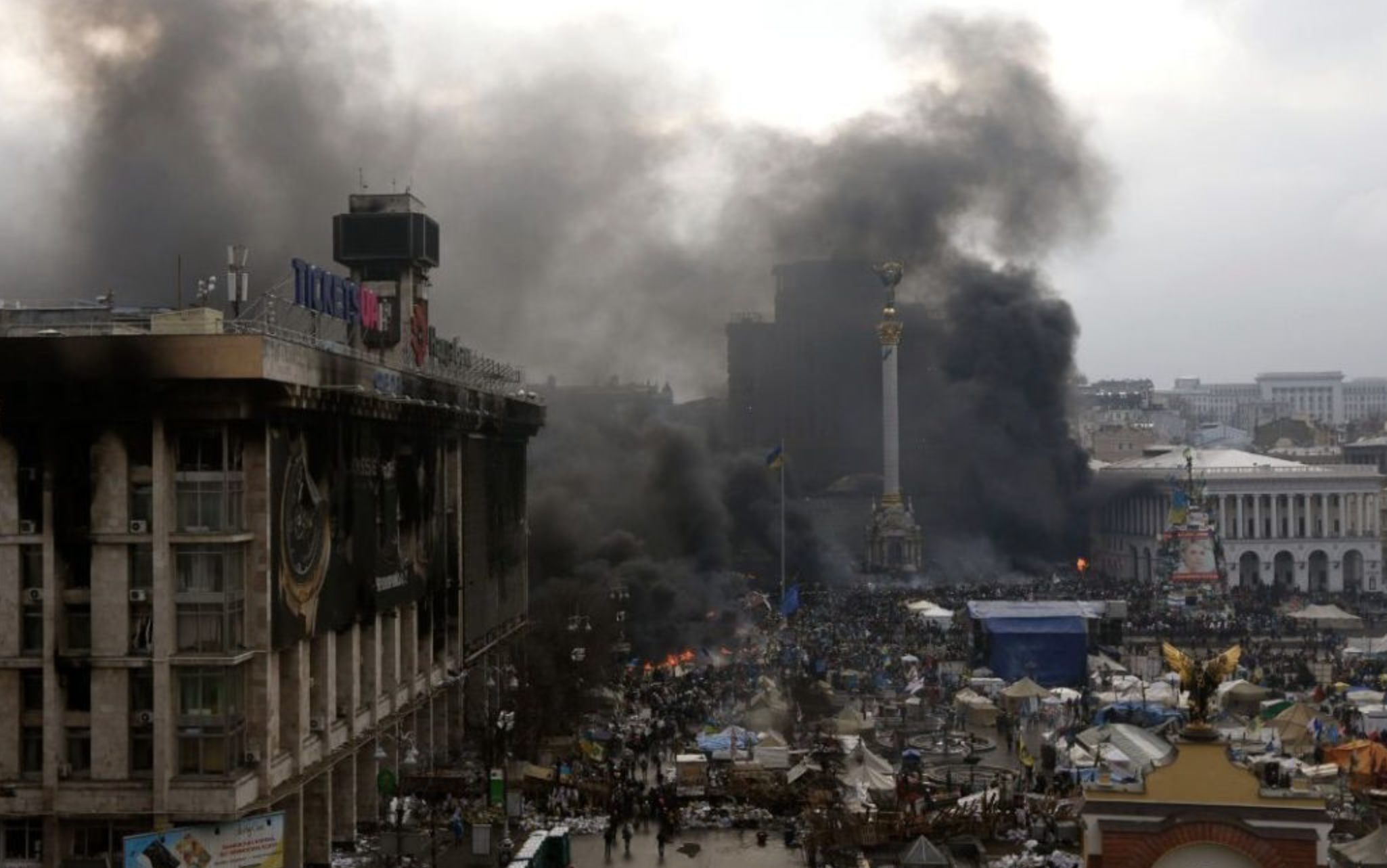
Independence Square, Kyiv, February 20, 2014. Photo: Reuters
While pointing out that eyewitnesses noticed or were told of gunfire coming from the Hotel Ukraine and other territory supposedly controlled by Maidan forces, Katchanovski mentioned the Arkada Bank as one of them[13]. The Arkada Bank was a multistory building located several meters behind the Khreshchatyk metro station. Maidan protesters never controlled this bank, even before the February 18 storming of the Maidan by Berkut and riot police. Their barricade was at the Khreshchatyk metro station. They did not occupy the bank. On February 20, the closest they had gotten to the bank was its concrete and metal sign along Instytutska Street. Many of those who made it that far wound up among the 48 killed that day.
Perhaps the most specious of Katchanovski’s arguments is that there were Georgian citizens, led by a U.S. military veteran with connections to Right Sector, and supposedly other citizens from the Baltic states, who had been recruited and deployed as snipers for the Maidan side. While citing numerous media coverage of this supposedly bombshell testimony, Katchanovski only repeats what the so-called Georgian snipers had said. There has been no evidence corroborating the presence of Georgian, Baltic, and U.S. snipers on the Maidan. Yet such types supposedly offered decisive proof that Andriy Parubiy, leader of Maidan Self-Defense, and former President of Georgia Mikhel Saakashvili, had given them orders to carry out the shootings[14]. Apparently, a mass shooting cannot be a mass shooting without a U.S. army veteran behind it.
The unknown snipers
What is significant about Katchanovski’s critique, though, is that it brings up a theme often silenced in accounts about the Maidan, namely, the unknown snipers from the Hotel Ukraine who fired on protesters and police. While we do not know their names, we know that they presented a serious problem on February 20. Dmytro Holubychnyi, a 16-year-old protester who, along with his father, had advanced up Instytutska Street that morning, recalled snipers from “both sides” [z obokh storin] trapping them, snipers from Instytutska Street (the Berkut snipers ahead of them), and those from behind them, from the Hotel Ukraine. Holubychnyi told a Lviv radio station that it was probably “God himself” who was the reason he survived[15].
Olha, the Maidan doctor who had organized a medical station in the Hotel Ukraine’s lobby, recalled when Maidan Self-Defense volunteers entered the lobby and said that there was a sniper firing from the building. People ran up to her and said, “You need to stop Self-Defense, because they’re going to set the Hotel Ukraine on fire, because a sniper is sitting above us, and he’s shooting at people!”[16]
“Guys came up,” Olha said, referring presumably to Maidan defenders, “and I said, ‘Guys, I need 20 minutes to evacuate the medical station right on the street. Set it on fire!,’ because the pain was simply unbearable, and I wanted to cry out to the whole world, that just because millions of people were silent now, that is, absolutely innocent people – these people were innocent, those whose bodies were lying there, they were without weapons, they were without bulletproof jackets, and they were intentionally killed, that is, the snipers didn’t shoot them in the legs, in the arms, they shot in the middle of the forehead, in the eyes, in the coronary arteries, and in the heart.”[17]

The first floor of the Ukraina hotel, where the wounded from Instytutskaya street were brought, Kyiv, February 2014. Photo: from open sources
Then some brigade of Afghan war veterans involved in the Maidan’s self-defense came downstairs and said that they had found the room where the sniper had been. They had discovered bullet shells from a rifle, but there was no sniper around.
“Who went through the lobby,” Olha recalled, “we had… It’s very hard to recall now, because I don’t remember faces from that time, and even now a lot of people, a lot of those wounded, whom I’d given aid on the 18th, the 20th, come up to me, hug me, and say, ‘Do you remember me?,’ and I can’t remember their faces, it’s all very [hazy]... [vse u takomu iakos’ sutsil’nomu…] I remember the whole time I was doing something. There was no time for emotions. My husband and daughter were out on the street. My husband helped carry wounded to the medical station with stretchers [Cholovik dopomahav prynosyty z nishamy poranenykh v medpunkt.]. My daughter also gave aid as a nurse.”[18]
Gabriel Gatehouse of the BBC was one of those who on February 20 witnessed someone with a Maidan Self-Defense green helmet firing at them, as he and his television crew stood below, across Instytutska Street, in front of the October Palace. They ran inside the October Palace for their safety. A year later, Gatehouse reported on this incident, as well as a later one in which a sniper from the same hotel fired on and killed Volodymyr Melnychuk. A confidential source in the General Prosecutor of Ukraine’s office told Gatehouse that there was a sniper in the Hotel Ukraine, and that evidence suggested he was firing at both sides. This source claimed he was putting together a case that indicated that the shootings on the Maidan were part of a plot aimed at seeding chaos. However, his investigations regularly ran into obstacles from the courts[19]. That was in 2015. By 2019, the General Prosecutor of Ukraine’s office had focused on the Berkut officers on trial, not on the Hotel Ukraine snipers[20].
There was no substantial proof that Maidan politicians had directed these unknown snipers, yet there were disturbing traces of their involvement with people who may have been among those snipers. Besides all the allegations raised about Poroshenko, there was Serhiy Pashynskyi, who soon became head of the Presidential Administration under interim president Oleksandr Turchynov. A video caught Pashynskyi on February 18 approaching a car surrounded by protesters on Lypska Street, during the clashes there that day. The protesters inspect the trunk of a Honda that has a state official’s license plate – AA 4774 SO – on it. The trunk turns out to have, in a protective case, a rifle with a silencer and a viewfinder. Next, a man looking like Serhiy Pashynskyi comes up to the car. He hides the rifle from others’ view, puts it back in the trunk, and closes the trunk. He speaks to someone who then drives the Honda off.
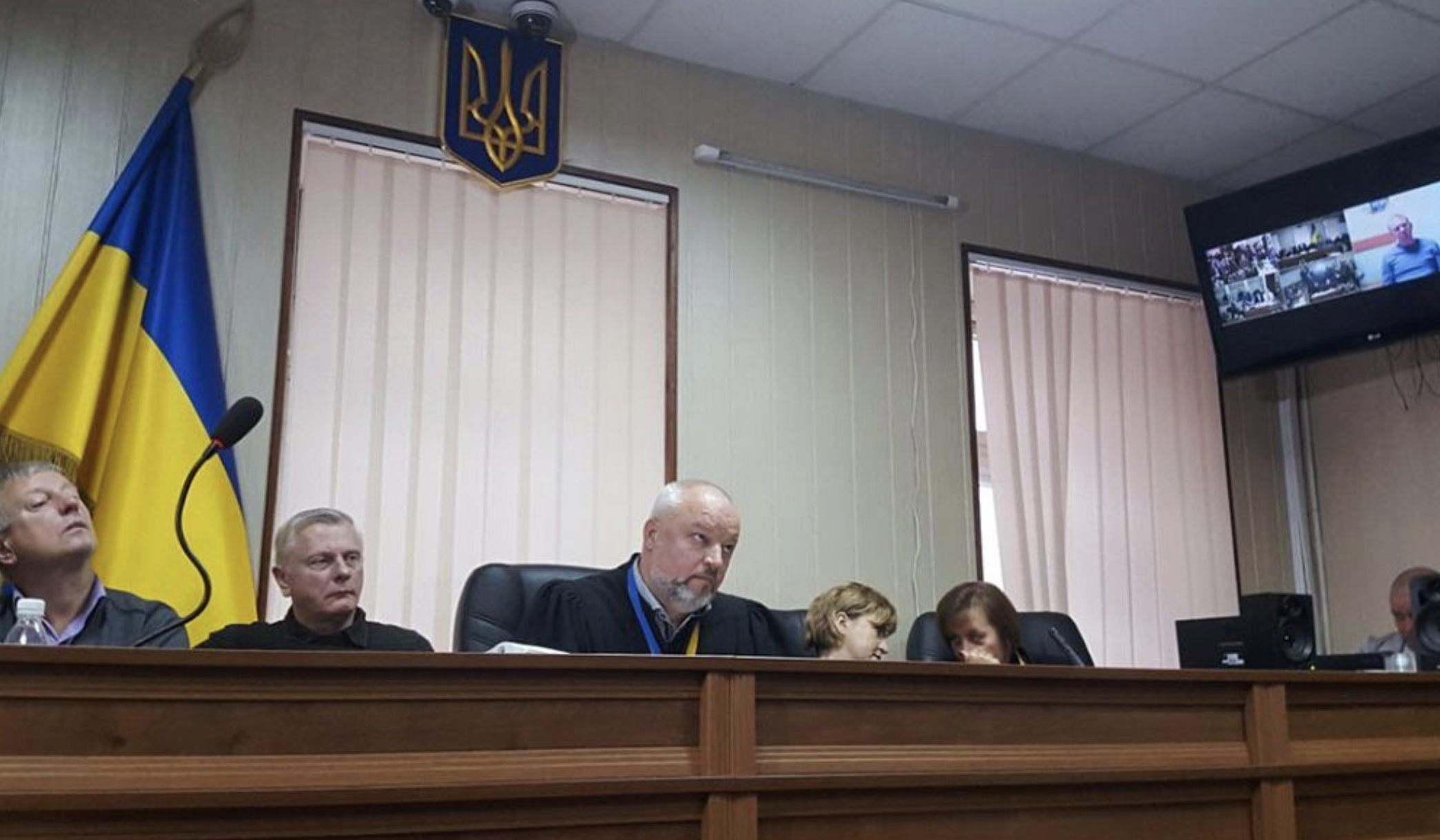
Ex-deputy Serhiy Pashynskyi testifies in the case of shootings on the Maidan by videolink, Kyiv, November 21, 2019. Judge Serhii Dyachuk is in the center. Photo: Tatiana Bezruk
A controversial blogger who was accused of working for the Kremlin, a Ukrainian nationalist who went by the name of Stepan Mazura, alleged that Pashynskyi, Turchynov, and Arsen Avakov – Ukraine’s Minister of the Interior after Yanukovych’s removal from power – had been behind arming protesters. They allegedly had covered up who had shot and killed protesters, a coverup that by then had lasted over a year. Katchanovski mentions similar allegations made by Maidan activists who said that Pashynskyi had appointed the chief investigator into the Maidan shootings at the General Prosecutor of Ukraine’s office, to keep Maidan politicians from being identified as suspects. Yet all of this remains speculation. While he admitted to Sonia Koshkina that it was him in this video, Pashynskyi refused to say he had supplied protesters with weapons. He insisted that the Honda belonged to one of their activists, and that it contained a hunting rifle for self-defense. Pashynskyi, as well as Turchynov, told Koshkina that Maidan protesters themselves decided to bring weapons because government forces had attacked their Peaceful Offensive on Parliament and then the Maidan itself on February 18[21].
While these snipers and their sponsors remain unknown, at least Katchanovski and Ukrainian investigators agreed that Russians were not among them. The Maidan massacre trial did not reveal any such evidence. Serhiy Horbatiuk, who had been chief investigator of the case, told Hromadske TV in early 2016 that no citizens of the Russian Federation were suspected of shooting protesters on February 20, 2014, though they were reviewing the activities of Russian emissaries who came to Ukraine and may have advised Ukraine’s leaders then[22]. The myth of the February 20 shootings being some Russian special operation had become ingrained in Ukrainians’ responses to the events, from Parubiy speaking to the BBC to the Kapranov brothers trying to understand the contradictory forensic and ballistic evidence. Russia also figures in Mychailo Wynnyckyj’s understanding of the February 20 massacre, though he admits that there still exists no proof that there was a connection between the snipers and the Russian Federation, and that the truth about the snipers may never be known[23].

Protesters set up a smoke screen by burning car tires on Hrushevskogo street, Kyiv, February 2014. Photo: UNIAN
Escalation: a Maidan already on the brink
Despite Katchanovski’s insistence that the February 20 shootings were needed as a false-flag operation to overthrow Yanukovych, it remains debatable if there was even a need for such a false flag operation by then. Already on the evening of February 18, men with rifles appeared on the Maidan for the first time. The February 19 truce was a de facto truce and could easily unravel, given that more and more people were suspected of planning to come to the Maidan with lethal weapons, including fertilizer bombs, as well as guns stolen from places like Lviv police stations. By the evening of February 20, there really was the danger of a sea of armed men going to war if the Yanukovych regime did not back down.
One friend mentioned that when he and other Lviv residents took a bus to the Maidan to defend it, this time on the night of February 20 – 21, one of them had a pistol he had stolen from one of those police stations. Some were coming up with new weapons to fight the police with, possibly explosives as well. Rodion, a soccer ultra who threw Molotov cocktails at police on Hrushevsky Street in late January 2014, told me that he had gotten involved in what he said were plans to come up with more serious weapons for self-defense. It was right after the Maidan shootings that day had ended when “we were told that we had to use more serious means of self-defense.” He said, “Thus, they told us to organize production in the shortest time possible, and thus I was a little occupied in another thing [other than being on the Maidan February 21].” He helped them start making those weapons, but then the fighting around the Maidan ended and the Yanukovych regime fell[24].
Maidan politicians used the February 18 - 19 uprisings in western Ukraine to threaten further violence against the state if the West did not take further actions against Yanukovych. Parubiy of Maidan Self-Defense was one of these people. On the evening of February 20, as he met with foreign ambassadors in the German embassy while intermediaries from Germany, France, and Poland were negotiating with Yanukovych, Parubiy denied claims that weapons protesters had seized in Lviv had reached Kyiv, but he suggested they might if the situation got worse: “I warned them that if Western governments did not take firmer action against Yanukovych, the whole process could gain a very threatening dimension.” The U.S. Ambassador to Ukraine, Geoffrey R. Pyatt expressed fears that such weapons could bring about an armed insurrection in Kyiv, which would undermine Western support for the protesters.
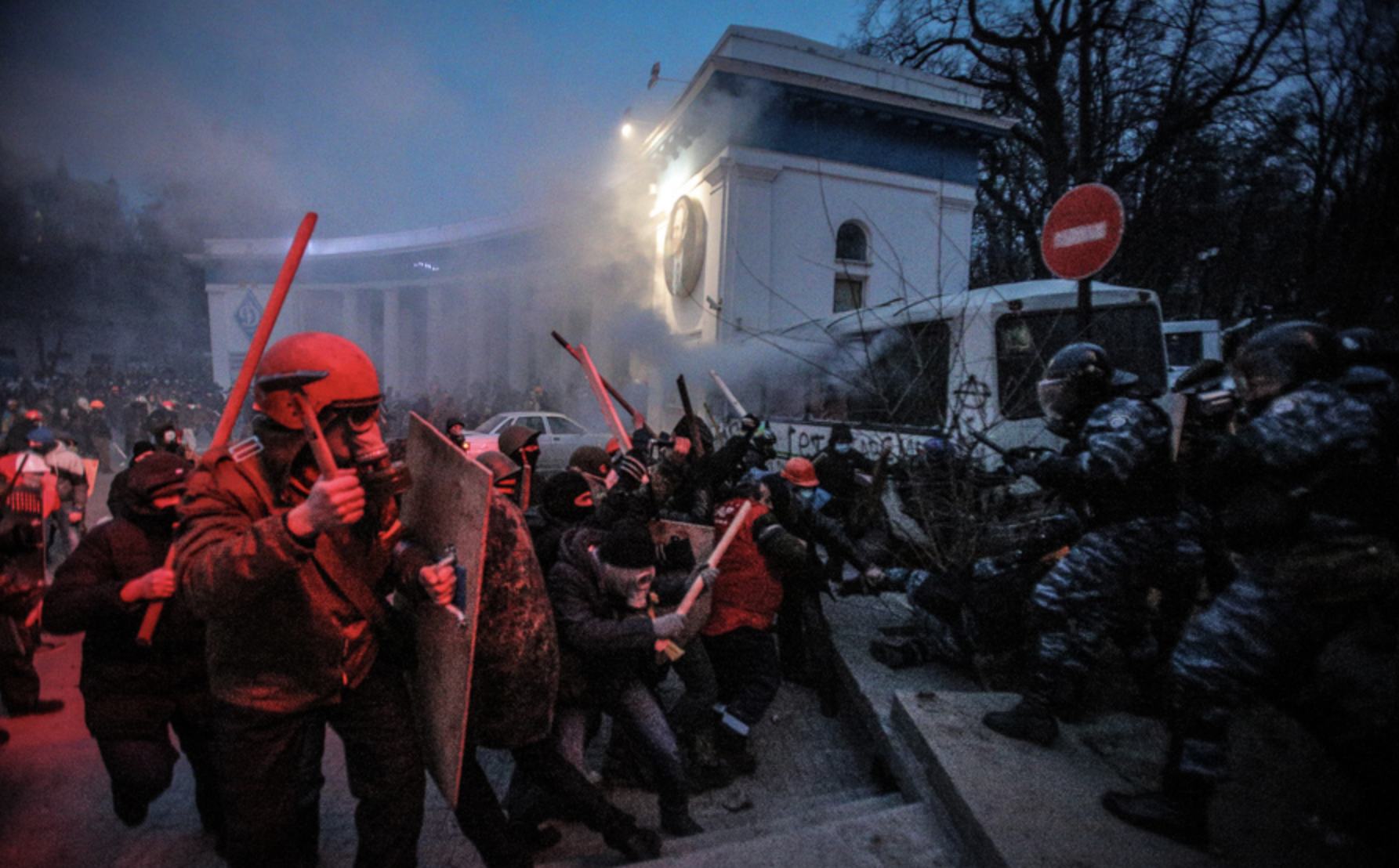
Clashes on the Maidan, Kyiv, February 2014. Photo: sodel.vlad
The rumors about automatic weapons on their way to Lviv alarmed Andriy Tereshchenko, who commanded Berkut forces from Donetsk, and who had been staying in the Cabinet of Ministers building with his men. Already on February 18, when the violence first flared up, 16 of his men had been shot. The automatic weapons from Lviv would make things even more dangerous for them. “We understood why the weapons were taken, to bring them to Kiev,” he told the New York Times[25]. The threat of men with guns from Lviv coming to Kyiv and bringing about a civil war was very real for politicians and security organs. The Maidan events on the morning of February 20 seemed like harbingers of worse bloodshed to come.
Conclusion: a revolution drowned in blood
The fact that the February 20 Maidan shootings never resulted in a proper conviction, after Maidan politicians and activists had taken power and dominated both the government and Parliament for over five years, from 2014 to 2019, was an open indictment of the revolution the Maidan allegedly had brought to Ukraine. Instead of changing the system, the system lived on and made everyone hostage to its injustices. The fact that so many political figures championing the Maidan became subjects of such rich conspiracy theories sadly demonstrates that Ukraine’s political class – not just the Party of Regions leaders, but their embittered opponents as well – had failed its citizens in a winter that changed everyone, but not always for the better.
On the weekend of February 22, 2014, foreign and diaspora audiences reveled in Yanukovych’s fall from power. They did not know that the bad guys were not going to prison. Yet even then, these celebrations were limited to certain social media echo chambers. The social media postings did not speak for all Ukrainians, especially in those regions where the support for the Maidan had been weak or almost nonexistent. In the Donetsk Region to the east, a man who observed those same events from his home computer as my Facebook friends had done failed to experience any jubilation. The director of a charity helping drug addicts and HIV/AIDS patients in the city of Sloviansk, Mykhailo, sensed more trouble was coming. When his wife asked him why he was so obsessed with events in Kyiv, he told her, “Kyiv has the Maidan, but we will have war” [V Kieve Maidan, a u nas voina budet.][26].
The war that Mykhailo referred to was the war in the Donbas. That war is beyond the scope of this article. Russia’s role in it became increasingly prominent as it evolved. Vladimir Putin and his advisors supported and exploited a “civil war” scenario in Ukraine as part of their geopolitical strategy to regain influence over it. Yet the Maidan shootings alarmed Donbas residents like Mykhailo. They confirmed the worst fears stoked by pro-Yanukovych media and politicians, as well as Russia’s leaders and Russian propaganda networks, over the winter of 2013 - 14. Maidan protesters had overthrown the state. They had humiliated and even shot and killed law enforcement. None of them were punished for it. Worse, because of their protests, the state had collapsed. Yanukovych and his associates were also responsible for their regime’s implosion, as well as the collapse of the state, but by the spring of 2014, such nuances no longer mattered.
The murky history of the Maidan shootings, and the failure to bring justice to the victims, legitimated a hybrid war that has since become an all-out war against Ukraine’s existence as a state. That struggle for Ukraine’s existence has made a more complex explanation of the Maidan shootings even more difficult. Instead of bringing justice and the rule of law to Ukraine, its revolution of 2013 - 14 seems swept aside as geopolitical forces have turned the Heavenly Hundred into a tiny drop in an ever-growing ocean of blood.
Footnotes
- ^ Ivan Katchanovski, “The far right, the Euromaidan, and the Maidan massacre in Ukraine,” Journal of Labor and Society 23 (2020): 5 – 29; Ivan Katchanovski, “The Maidan Massacre Trial and Investigation Revelations: Implications for the Ukraine – Russia War and Relations,” Russian Politics 8 (2023): 181 – 205.
- ^ Katchanovski, “The Maidan Massacre Trial;” Katchanovski, “The far right,” 21.
- ^ Ibid., 196 – 97; Mattathias Schwartz, “Who Killed the Kiev Protesters? A 3-D Model Holds the Clues,” The New York Times, May 30, 2018, accessed August 25, 2023. The SITU findings are at this website: http://maidan.situplatform.com/, accessed August 25, 2023. The New York Times piece also obfuscates the Maidan protests’ history, stating, for instance, that protesters by December 2013 were occupying government buildings and setting them on fire. It falsely claims that protesters on February 20 were trying to march on Parliament.
- ^ “Report of the International Advisory Panel on its review of the Maidan Investigations,” International Advisory Panel, Council of Europe, March 31, 2015, 63 – 67, accessed September 4, 2023.
- ^ Ibid., 67 – 68.
- ^ Ibid., 84 – 85.
- ^ Ibid., 67 – 68; Katchanovski, “The Maidan Massacre Trial,” 183.
- ^ “Report of the International Advisory Panel,” 44 – 47, 81 – 83.
- ^ Ibid., 68.
- ^ Katchanovski, “The Maidan Massacre Trial,” 187; Braty Kapranovy, Maidan: Taiemni faily (Kyiv: Nora-Druk, 2017), 67 (The page numbers are from the online version of the book, accessed July 16, 2023).
- ^ Katchanovski, “The far right,” 16; “BRANTSI Veb Serial, chetverta chastyna/CAPTIVES Web Series Part Four,” published on YouTube by #BABYLON’13 on May 14, 2016, accessed August 21, 2023, minute 17:00.
- ^ Katchanovski, “The far right,” 17; “Instytuts’ka 20 liutoho. Vbyvstvo maidanivtsiv.,” published on YouTube by Poshukova Hrupa on December 5, 2014, accessed August 22, 2023.
- ^ Katchanovski, “The Maidan Massacre Trial,” 188.
- ^ Ibid., 184 – 185, 190; Katchanovski, “The far right,” 16 – 17.
- ^ “Khlopets’ iakyi vrazyv ves’ svit… Vidverta rozmova z Dmytrykom. (27.02.2014),” radio L’vivs’ka Khvylia, February 27, 2014, accessed January 30, 2016.
- ^ Olha B., interview with Ukrainian Institute of National Memory, Kyiv, December 22, 2014. In the original: “Tobi treba zupynyty samooboronu, bo vony idut’ pidpaliuvaty hotel’ ‘Ukraina’, bon ad namy sydyt’ snaiper i striliaie po liudiakh!”
- ^ Ibid. In the original: “Khloptsi pidiyshly, ia kazhu, ‘Khloptsi, meni treba 20 khv, shchoby evakuiuvaty medpunkt prosto na vulytsiu. Pidpaliuyte!’, tomu, shcho bil’ bula prosto nesterpna i khotilos’ krychaty do vs’oho svitu, shcho til’ky tomu, shcho mil’iony liudei zaraz movchat’, tobto, absoliutno nevynni liudy – tsi liudy buly nevynni, iaki lezhaly tila, vony buly bez zbroi, vony bulo bez bronezhyletiv i vony buly vbytymy na znyshchennia, tobto, snaipery ne strilialy po nohakh, po rukakh, vony strilialy v seredyni loba, v ochi, v koronarni arterii i v sertse.”
- ^ Ibid.
- ^ “Snipers at Maidan: The untold story of a massacre in Ukraine – Newsnight,” posted by BBC Newsnight on YouTube February 12, 2015, accessed December 28, 2015.
- ^ Katchanovski, “The Maidan Massacre Trial,” 195.
- ^ Ibid., 194; “Sled po delu ‘Nebesnoi Sotni’ vedet k Arsenu Avakovu (10.09.2015),” posted by Stepan Mazura on Youtube September 10, 2015, accessed December 29, 2015. For his blog on this, see Stepan Mazura, “Petro Poroshenko prychetnyi do rozstrilu heroiv ‘Nebesnoi Sotni,’” September 11, 2015, accessed December 29, 2015; Sonia Koshkina [Ksenia Vasylenko], Maidan: Nerozkazana istoriia (Kyiv: Brait Star Pablishing, 2015), 233 – 234.
- ^ “Perelom. 20 fevralia 2014 goda,” published on YouTube by hromadske on February 23, 2016, accessed August 26, 2023, minute 31:43.
- ^ Braty Kapranovy, Maidan, 150; “Snipers at Maidan;” Mychailo Wynnyckyj, Ukraine’s Maidan, Russia’s War: A Chronicle and Analysis of the Revolution of Dignity, with a foreword by Serhii Plokhy (Stuttgart: ibidem-Verlag, 2019), 125.
- ^ Rodion V., interview with the author, tape recording, Kyiv, March 22, 2014.
- ^ Andrew Higgins and Andrew E. Kramer, “Ukraine Leader Was Defeated Even Before He Was Ousted,” New York times, January 3, 2015, accessed January 21, 2016.
- ^ Mykhailo K., interview with the author, Sloviansk, December 21, 2014.
